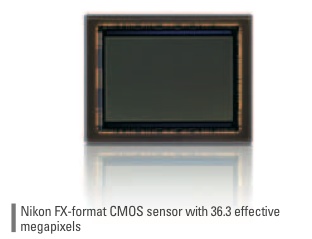Forget theory.
I am tired of reading high falutin’ theories about digital sensor limitations. Diffraction this, pixel size that. Frankly, none of this meshes with my experience which is that the only objective measure is …. subjective.
Yesterday Nikon announced its latest full frame DSLR, the D800, with a 36mp Sony sensor. That’s more than three times the pixels in the D700, which is renowned (along with the like sensor in the D3) as the class leading low light/high ISO performer. If it measures up then a lot of people will have their Nikkors in a twist as the sensor will brutally disclose the shortcomings of their non-pro grade optics.

The D800 sensor.
Now I’m reading that D800 users will find that even their pro lenses are not good enough for the new sensor. The oft read statement is that “the sensor outresolves the lens”. Poppycock. A perfect example is my experience with the G1 and G3 Panasonics, with MFT sensors whose area is just 25% of full frame. When the 12mp G1 sensor gave way to the 16mp G3 version there was lots of noise about …. noise. As in “the new sensor will be too noisy, it has too many pixels”. Utter nonsense. Large continuous tone areas with the G3, using the same lenses as on my G1, are so superior for lack of noise that it’s simply no contest. I’m talking based on 18″ x 24″ prints here. Scale that sensor up to full frame and you have a 64mp monster. And why not if it’s better? We can expect to see pixel counts increase for the foreseeable future.
Another example which makes a complete nonsense of pixel counts in the opposite direction is the Canon 5D. This was a mere 12mp if I recall, yet mine would yield superb huge prints from that low pixel count sensor. By all accounts the Nikon D700 in the mail to me is comparable, with even better low light performance. I bought that body fully aware that it was about to be obsoleted by the D800, widely rumored at 24-36 mp. I don’t need the movie mode and pixel count is meaningless to me. Only the results count.
Bottom line? Forget the pixels. Look at big prints.
And if you want real bragging rights, get the Nikon 800E which deletes the anti-aliasing (jaggie removal) filter. It’s extra, of course:

Nikon chutzpah. Charge more for less.
More seriously, it’s not beyond the realm of possibility that the D800E, with its sharper image, will sound the death knell of ridiculously priced medium format digital cameras and their massive lenses. Henceforth, billboards and Safeway delivery trucks will be decorated using massive enlargements from a four pound camera/lens combination costing less than one Hasselblad lens and you will be able to buy four or five such combinations for the price of one Hasselblad body. And as it says ‘Nikon’ on the faceplate, instant acceptance is accorded to the owner of the hardware, no excuses required. Assuming the snapper’s expertise is in subjects other than brick walls and test charts, that is.